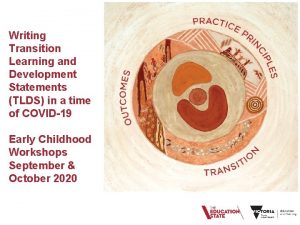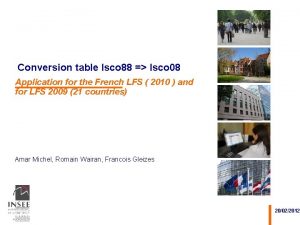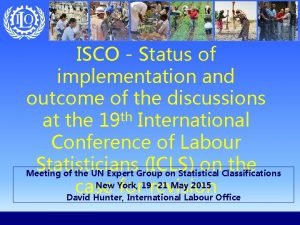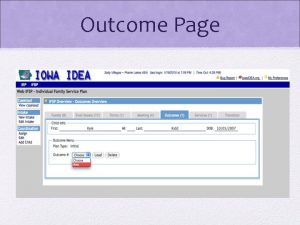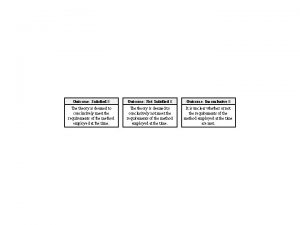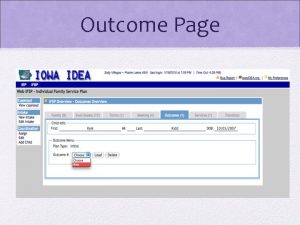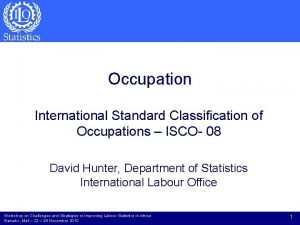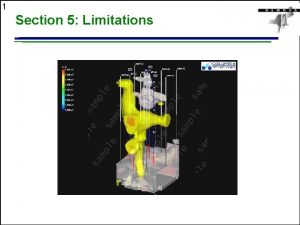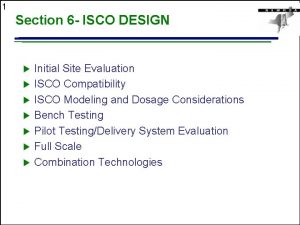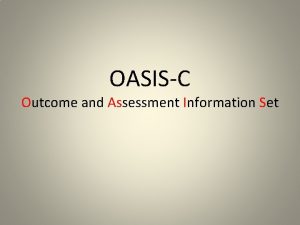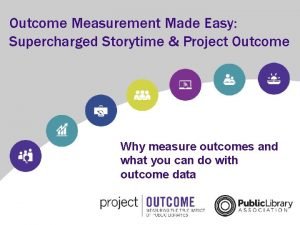ISCO Status of implementation and outcome of the




























- Slides: 28

ISCO - Status of implementation and outcome of the discussions at the 19 th International Conference of Labour Statisticians (ICLS) on the case for revision Meeting of the UN Expert Group on Statistical Classifications New York, 19 -21 May 2015 David Hunter, International Labour Office

Contents • 19 th International Conference of Labour Statisticians (ICLS) and relevance to international classifications – Resolution concerning statistics of work, employment and labour underutilization • Status of implementation of ISCO • The case for a revision or update of ISCO ILO Department of Statistics 2

19 th ICLS topics relevant to classifications • Resolution concerning statistics of work, employment and labour underutilization – Update of the international standards for statistics of the economically active population, employment, unemployment and underemployment – Comprehensive framework for statistics of work Ø Moves the boundary between employment and other forms of work, with consequences for the content and/or scope a number of international classifications including ISCO, ICSE and ICATUS. – Set of measures of labour underutilization in addition to the unemployment rate • Case for a revision or update of ISCO • Revision of International Classification of Status in Employment

Why was there a need for new standards for statistics on work, employment and labour underutilization? • Requested by 18 th ICLS and UNSC, 39 th session (2008) • In response to calls to address limitations of unemployment statistics (2003 job crisis; 2008 financial crisis) • In response to criticisms of employment as a measure that was too broad • Provide measures of labour underutilization, beyond unemployment • Recognize and provide framework for measurement of all work, paid and unpaid • Facilitate integration of labour statistics with other domains ILO Department of Statistics 4

19 th ICLS Resolution 1 • Key features of the resolution concerning statistics of work, employment and labour underutilization include: – The introduction of a reference concept work and an associated conceptual framework forms of work; – Operational definitions and guidelines for each form of work and for measures of labour underutilization; – A set of indicators for monitoring labour market performance including three new headline indicators of labour underutilization, in addition to the unemployment rate.

Impact on classificatrions • Elements that have a particular impact on international classifications – reference concept of work, – definitions of each form of work, – refinement of the definition of the statistical unit job, which is the unit classified by ISCO and ICSE.

Work 1 st international statistical definition Ø Any activity performed by persons of any sex and age to produce goods or to provide services for use by others or for own use. • Irrespective of legality, formal / informal nature of activity, context or person status • Consistent with the scope of productive activities – Within the SNA General production boundary – Complete accounts (“national” and “satellite” accounts) • Five mutually exclusive forms of work are identified for separate measurement, distinguished on the basis of: – the intended destination of the production (for own final use; or for use by others, i. e. other economic units) – the nature of the transaction (i. e. monetary or non-monetary transactions, and transfers),

Work and the 2008 SNA (1) • Aligned with General production boundary (2008 SNA) – Activity must result in production of goods or services – Activity must fulfill 3 rd person criterion: i. e. it must be possible for someone else to perform the activity on one’s behalf • Can be performed in any kind of economic unit – Market units (i. e. for profit units, such as corporations, quasicorporations and household unincorporated market enterprises) – Non-market units (i. e. government & non-profit institutions) – Households producing goods or services for own final use Enables coherence between work statistics and economic statistics ILO Department of Statistics 8

“Work” and the 2008 SNA (2) Activities Nonproductive activities Sleeping Learning Own-recreation Begging Stealing Productive activities Non-market Market units Households units Incorporated, producing for own final use Service s ed d lu c In Government, Non-profit institutions Goods Service s Goods unincorporated Service s Goods Previous activity scope for “employment” New concept of “Work” == productive activities SNA General productio n n boundary ILO Department of Statistics 9

5 Forms of Work to be measured separately Work (i. e. ALL activities to produce goods and services) For own final use (by households) Own-use production work S G ILO Department of Statistics For use by others (i. e. other units) For remuneration (i. e. for pay or profit) Employment (work for pay or profit) Services Goods Without remuneration Unpaid trainee work S G Other work activities (e. g. unpaid compulsor y work) S G Volunte er work G S 10

Forms of work Own-use production work • production of goods and services for own final use Employment work • work performed for others in exchange for pay or profit Unpaid trainee work • work performed for others without pay to acquire workplace experience or skills; Volunteer work • non-compulsory work performed for others without pay; Other work activities

19 th ICLS Definition of job and ISCO concepts • Job or work activity: – a set of tasks and duties performed, or meant to be performed, by one person for a single economic unit – the term ‘job’ is used in reference to employment. – This statistical unit, when relating to own-use production work, unpaid trainee work, and volunteer work is referred to as work activity Ø Occupation • a set of jobs or work activities whose main tasks and duties are characterised by a high degree of similarity – Employment • work performed for others in exchange for pay or profit

International Standard Classification of Occupations 2008 (ISCO-08) – Adopted (exceptionally) by a tripartite Meeting of Experts in 2007 – Endorsed by the ILO Governing Body in 2008: • For this reason it is known as ISCO-08 • Structure and group definitions available on ILO Website since 2009 • Volume 1 Published in English in 2012 – Many countries have updated or are currently updating their national occupation classifications to align with ISCO-08 • Used in European Union collections from 2010 onwards • Structure available in all EU languages on request Department of Statistics

Support for implementation 1 - Documentation Publication and dissemination in book form and on web: • Volume 1: Structure, group definitions, and correspondence tables • Part 1: Introductory and Methodological notes • Part 2: Classification structure • Part 3: Group Definitions • Part 4: Correspondence tables with ISCO-88 • English and Russian published, • French and Spanish are available and in final stages of preparation for publication • Arabic version is being developed • Volume 2: Index of occupational titles • Map between real world terms used to describe jobs and ISCO-08 unit groups • To be published in alphabetical and numerical order • English, French and Spanish versions are available Planned manual on adapting ISCO for national and regional use • Resources have not been available to undertake this work but a considerable amount of information can be found in the Introductory and Methodological Notes

Support for implementation 2 - Training and technical support • Provision of training on a regional or sub-regional basis – Training materials are available on request • Provision of technical assistance and advice directly to countries – short visits to countries (ILO staff or consultants) – review of material and provision of advice – assistance in finding consultants or setting up collaboration with other countries • Assistance with and review of correspondences between national classifications and ISCO-08 • Discussion forum hosted by Eurostat but open to all countries (registration required) • ECLAC Working Group on International Classifications (GTCI) discussion forum

Case for a revision or update of ISCO-08 UN Expert Group on • Governing authority should consider at least every five years, a review outlining the case International Statistical for a revision, an update or no change to Classifications international reference classifications Short paper circulated during 2013 to selected experts in occupation classification outlining known issues • Comments and suggestions from experts are were reported to ICLS and are summarised in the report to the EG The Expert Group envisages two possible • the revision types of change to • and the update international classifications:

Revision versus Update Revision implies major changes that entail one or more of : • Renumbering all or a substantial portion of the classification structure • Restructuring and regrouping a substantial portion of the classification; • New concepts for defining groups at one or more levels of the classification hierarchy Update implies more limited changes: • Addition or removal of a category at the most detailed level of the classification within the existing structure • Realignment of the content of categories – an occupation moves from one unit group to another • Multiple categories added or removed from the most detailed level – basic structure remains substantially unchanged

Issues that could only be addressed in a full review Problems with the application of skill level as a classification criterion • Breadth of Skill level 2 • Boundary between Skill Levels 2 and 3 Usefulness of ISCO for the measurement of skill mismatch • Internationally harmonized method for the measurement of skills mismatch is a high priority • indicator of labour underutilization • analysis of problems of supply and demand of skilled labour • skills shortages • Inherently difficult task • Any work to review or update ISCO-08, would need to consider these issues

Mapping of ISCO-08 major groups to skill levels Department of Statistics

Breadth of Skill Level 2 Ø Distinction between occupations that require completion of extensive vocational education and training, and those that require a short period of training plus basic literacy and numeracy is not made systematically Ø Occupations that vary significantly in skill level but are similar in skill specialization, are frequently grouped together Ø Limits the usefulness of the classification for analysis and measurement of § skill level requirements § skill mismatch § income as a return to education § educational planning § socio-economic status. Department of Statistics

Boundary between Skill Levels 2 and 3 • Problems with the boundary in skill level between Ø more skilled technical occupations classified at Skill Level 2, Ø and occupations at Skill Level 3 included in Major Group 3, Technicians and Associate Professionals • Technological changes are leading to higher knowledge and skill requirements some of the more technical occupations in Major Group 7, Craft and Related Trades Workers Ø vehicle and aircraft maintenance Ø electrical, electronics and telecommunications installation and maintenance • Distinction between a technician and a repairer or mechanic is no longer clear cut Department of Statistics

Options to address problems with skill level as a classification criterion Move boundary between Skill levels 1 and 2 up • Some clerical occupations, sales assistants, accessory installers and most plant and machine operators and drivers move to Skill Level 1 • Major group 8 at Skill Level 1: more skilled occupations to Major group 7 5 skill levels at unit group level - splitting Skill level 2 • Each unit group in Major Groups 4, 5, 6, 7 and 8 is associated with a single skill level • These major groups each include occupations at two skill levels • Current major and minor group structure can be retained 5 skill levels mainly at major group level • Data on skill level can be compiled from aggregate statistics • More radical change to major group structure • Mainly affects Major Groups 4 and 5 Move boundary between Skill Levels 2 and 3 • More highly skilled occupations within the current Skill Level 2 are classified at the new Skill Level 3. • Some occupations move from Major Groups 7 and 4 to Major Group 3 • Could be combined with any of the above approaches Department of Statistics

Issues that could be addressed in a minor update: health occupations • Further breakdown for specialist medical practitioners, for example – – – • • General paediatricians Obstetricians and gynaecologists Psychiatrists Medical group of specialists Surgical group of specialists Other specialists not elsewhere classified Oral and maxillofacial surgeons Medical technologists Radiographers and Radiological technologists (new!) Occupational therapists (new !)

Issues that could be addressed in a minor update: other occupations • Hospitality and retail managers • Operators of small hospitality establishments • Company secretaries and corporate governance specialists • Information and communications technology specialists • Additional unit groups for supervisory occupations especially in the services sector • Subsistence Farmers, Fishers, Hunters and Gatherers – Removal of a sub-major group! • Home improvements installers • Vehicle accessory fitters • Trades Assistants • Armed Forces

Arguments for and against a short term update Some experts and stakeholders believe a short-term update should be a priority • • Keeps ISCO up-to-date and relevant in a rapidly changing world of work More useful and acceptable in clientoriented applications Classification is more easily accepted and likely to be used by professional associations that are dissatisfied with current categories Small incremental changes may soften breaks in time-series introduced by a major revision Others believe that an update would be premature at this stage • • • Many countries are in the process of implementing ISCO-08 in national statistics Need for a more thorough evaluation of the classification before any changes are made Structural problems not addressed Implementation costs in national statistical and administrative systems Impact on international comparability of data for the same reference period, since all countries would not implement the updated version at the same time Opportunity cost for ILO

19 th ICLS Conclusions on revision of ISCO • No consensus on the need for a short-term update • Concern about the timing of a deeper revision in relation to the 2020 round of censuses. – Starting the preparatory work for a revision of ISCO-08 only after the 20 th ICLS might mean that few countries would be able to implement the new classification until the 2030 round. • It was suggested that a useful approach might be for the ILO to establish a technical group and/or a knowledge-sharing platform to reflect the lessons learned in the implementation of ISCO-08 in order to identify common issues and document the improvements needed. • A more thoroughly considered set of options for revision could then be developed in advance of the 20 th ICLS.

Thank you ILO Department of Statistics 27

Resources and Contact • 19 th International Conference of labour statisticians http: //www. ilo. org/19 thicls • ICLS Resolutions and Guidelines http: //www. ilo. org/global/statistics-and databases/standardsand-guidelines/ • STATISTICS contact statistics@ilo. org ILO Department of Statistics 28
 Eczacı teknikerinin görevleri
Eczacı teknikerinin görevleri The reformation outcome martin luther and the reformation
The reformation outcome martin luther and the reformation Dpgt full form
Dpgt full form Veyldf learning and development outcome descriptors
Veyldf learning and development outcome descriptors Counseling outcome research and evaluation
Counseling outcome research and evaluation The age of exploration outcome china and japan's reactions
The age of exploration outcome china and japan's reactions Japan during the age of exploration
Japan during the age of exploration Wsib msk care and outcome summary
Wsib msk care and outcome summary Examples of educational goals and objectives
Examples of educational goals and objectives The reformation outcome martin luther and the reformation
The reformation outcome martin luther and the reformation Ancient egypt and judaism outcome the new kingdom
Ancient egypt and judaism outcome the new kingdom Who won battle of lexington and concord
Who won battle of lexington and concord Hình ảnh bộ gõ cơ thể búng tay
Hình ảnh bộ gõ cơ thể búng tay Ng-html
Ng-html Bổ thể
Bổ thể Tỉ lệ cơ thể trẻ em
Tỉ lệ cơ thể trẻ em Chó sói
Chó sói Tư thế worms-breton
Tư thế worms-breton Chúa yêu trần thế
Chúa yêu trần thế Môn thể thao bắt đầu bằng từ đua
Môn thể thao bắt đầu bằng từ đua Thế nào là hệ số cao nhất
Thế nào là hệ số cao nhất Các châu lục và đại dương trên thế giới
Các châu lục và đại dương trên thế giới Công của trọng lực
Công của trọng lực Trời xanh đây là của chúng ta thể thơ
Trời xanh đây là của chúng ta thể thơ Cách giải mật thư tọa độ
Cách giải mật thư tọa độ Làm thế nào để 102-1=99
Làm thế nào để 102-1=99 Phản ứng thế ankan
Phản ứng thế ankan Các châu lục và đại dương trên thế giới
Các châu lục và đại dương trên thế giới Thể thơ truyền thống
Thể thơ truyền thống



